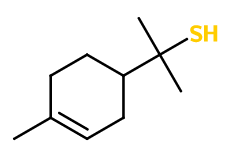
Photo credits: ScenTree SAS
Grapefruit Mercaptan
Grapefruit Mercaptan ; Menthenethiol ; 2-(4-methyl-1-cyclohex-3-enyl)propane-2-thiol ; Para-menth-1-ene-8-thiol ; 1-para-menthen-8-thiol ; Para-menthene thiol ; Terpinyl mercaptan ; Alpha,alpha,4-trimethyl cyclohex-3-ene-1-methane thiol

Photo credits: ScenTree SAS
Do you sell any of the raw materials? Would you like to let our users know?
Send an email to fournisseurs@scentree.coto learn about our advertising opportunities.
Do you sell any of the raw materials? Would you like to let our users know?
Send an email to fournisseurs@scentree.coto learn about our advertising opportunities.
General Presentation
-
CAS N° : 71159-90-5
-
EINECS number : 275-223-1
-
FEMA number : 3700
-
Density : 1,025
-
Optical rotation : Donnée indisponible
-
Allergens : This ingredient does not contain any allergen.
-
Refractive Index @20°C : Donnée indisponible
-
Volatility : Head
-
Price Range : €€€€
-
Appearance : Colorless liquid
-
FLAVIS number : 12.085
-
JECFA number : 523
Information on synthetic ingredients
-
Acid Value : Donnée indisponible
-
Boiling Point : 110°C (à 2 mmHg)
-
Detection Threshold : Le Sulfure de limonène possède l'un des seuils de détection les plus faibles de la parfumerie : 0,00005 ppb. (0,000000000005%)
-
Molecular formula : C10H18S
-
Log P : Donnée indisponible.
-
Molecular Weight : 170,32 g/mol
-
Fusion Point : Donnée indisponible.
-
Flash Point : 75°C
-
Vapor pressure : Donnée indisponible
Uses
Other comments :
When it is pure, only a very powerful sulfured smell is detected. In dilution, the smell of Grapefruit Mercaptan becomes more pleasant and reminisces of grapefruit
Stability :
Stable in perfumes and diverse functional bases
Uses in perfumery :
Grapefruit Mercaptan is used in sulfuric, fruity-exotic and vegetable notes. Also used in colognes and eaux fraiches as a booster. Often diluted directly in D-Limonene by suppliers.
Year of discovery :
Data not available.
Isomerism :
Grapefruit Mercaptan has an asymmetric carbon. However, the distinction between the two possible enantiomers is not made in perfumery. It is the mixture of the two isomers that is used in majority. The isomer (R) of the molecule is considered more powerful, as it has an extremely low detection limit of 200 nanograms/kg, against 800 for the isomer (S).
Synthesis precursor :
Grapefruit Mercaptan is not a precursor to the synthesis of another compound of olfactory interest.
Natural availability :
Natural Grapefruit Mercaptan can be extracted from Grapefruit EO. However, synthetic Grapefruit Mercaptan is most often used in perfumery.
Synthesis route :
Grapefruit Mercaptan is synthesized in an alkaline medium, by reaction between hydrogen sulfide and the corresponding alcene, derived from para-Menthene.
Regulations & IFRA
This ingredient is not restricted

